The hiring process presents some of the most complex – and important – decisions that any organization must face. Finding and hiring the right people is crucial to the long-term success of any business, which is why many organizations have candidates screened and evaluated by multiple interviewers, so that they can get a diversity of opinions to identify the best candidates. The trouble is that it can be challenging for companies to synthesize the sentiment of all the interviewers and truly realize the benefits of multiple opinions to ultimately make informed, optimal decisions on who best would fit their culture, needs, and compensation requirements.
In nature, swarms of bees, flocks of birds, and schools of fish face similarly complex decisions, but with even higher stakes. For a swarm of bees, the decision about where to place their hive is quite literally a matter of life-or-death, and so these relatively simple organisms must find a way to solve this multivariable problem consistently and optimally. Because no individual bee could even conceive of the problem, much less solve it, nature has evolved a method for amplifying the intelligence of teams called Swarm Intelligence, which empowers bees to find the optimal location for their hive over 80% of the time.
Now, Unanimous AI has created the Swarm platform, which brings the power of Artificial Swarm Intelligence (Swarm AI) to human teams and groups of all kinds. The benefits of amplified intelligence can be realized across business organizations, from sales forecasting to product prioritization, but one of the highest-ROI applications has been found in the Human Resources department.
Some customers have suggested that the Swarm platform has made their decision-making process as much as 3x faster, because it enables the group to rapidly converge upon consensus, rather than suffer through extended debates and subjective discussions. And, because the Swarm platform provides a wealth of information about how candidates are perceived and considered, more difficult decisions can be made with far greater confidence.
Since hiring decisions often include both multiple candidates and multiple interviewers, there are myriad strategies for collecting and distilling input into a final decision. This post will examine two popular methodologies and demonstrate how the Swarm platform can help inform hiring decisions with unprecedented insight.
ATTRIBUTE RANKINGS
A popular strategy for assessing candidate viability is to have each interviewer rate the candidate on a 5- or 10-point scale on various attributes (skills, experience, culture fit, etc.) . Each interviewer meets with the candidate and scores them. Afterwards, scores are tallied, and an average score is given to each candidate for each attribute..
While this may seem to be a scientific approach, there are multiple problems. First of all, interviewing groups are generally not large enough to be statistically significant, making the averages unreliable. Secondly, studies have shown that individuals have different internal scales for quantifying ratings. In other words, Bob’s 9 might be different than Lucy’s 9. So again, the resulting average score may be skewed. Finally, this approach is passive. Each interviewer considers each candidate in isolation, without communicating with each other and gaining the benefit of their combined insights.
With Swarm, attribute rating is different. Interviewers work together as an interactive, real-time system to bring their wisdom, intuition, experience and insight to the process, and then empowers them to collectively converge on the output that best satisfies the group. By rating candidates together as a Swarm AI system, interviewers react and interact in real-time, moderated by AI algorithms that process behaviors and estimate relative conviction levels, so that the scores represent a true consensus.
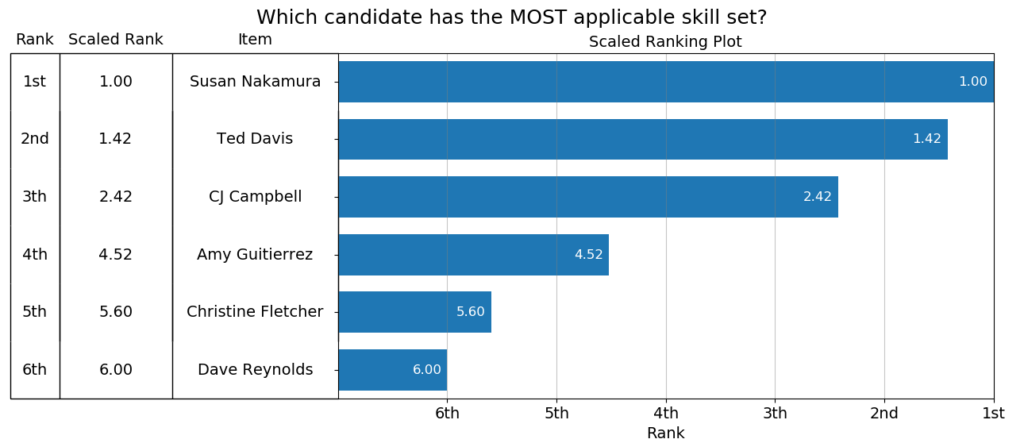
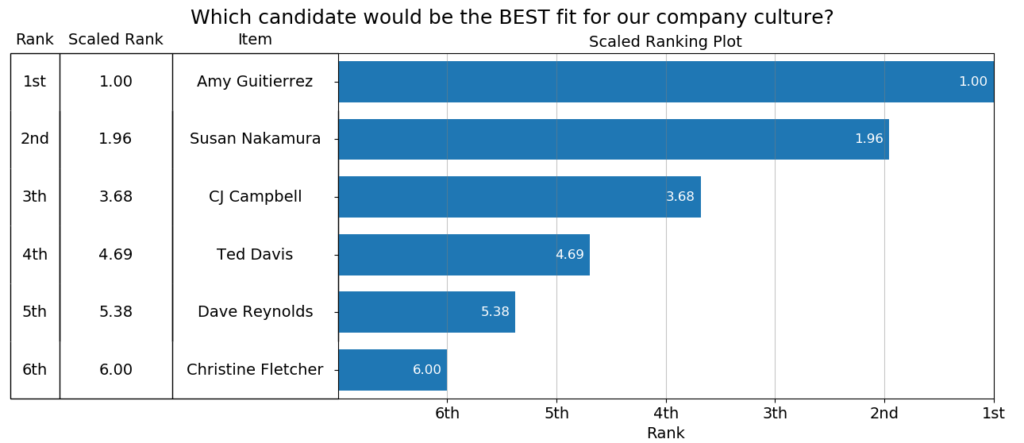
In addition to using Swarm for scaled rating questions, Hiring Teams can also leverage an iterative elimination process that allows the group to consider each candidate repeatedly, and in context, against every other candidate. For each attribute, up to 6 candidates can be considered, with the interviewers eliminating the lowest ranking candidate. The process is repeated until the top candidate emerges.
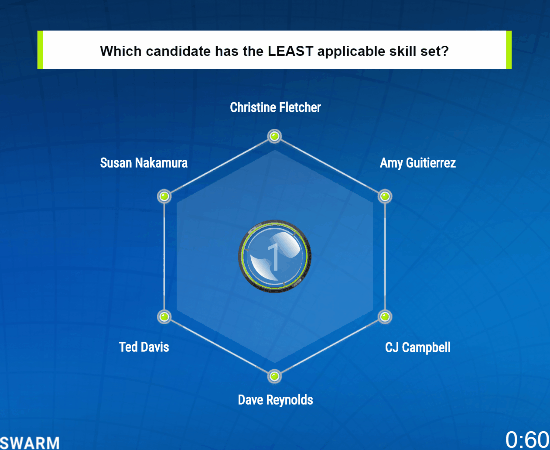
Each of the magnets in the replay above represents one member of the hiring team as they converge on the most collectively satisfying response. In contrast to a simple survey or poll, wherein each vote is offered discretely and never reconsidered, the Swarm platform offers real-time feedback, which compels each participant to constantly reassess their position until an AI-optimized output is achieved. This iterative process means that the insights produced by a hiring team using the Swarm platform offers a far-richer set of data on which a decision can be made.
HEAD-TO-HEAD COMPARISON
A second methodology for using the Swarm platform in the hiring process is head-to-head comparisons. Instead of rating candidates individually, they are compared to each other, forcing the interviewers to choose one. Multiple candidates can be compared this way, across multiple attributes. This is particularly useful when candidates’ differences are small. In the replay below, the two candidates’ likelihood of remaining at the company for a long period of time is assessed both in terms of direction and amplitude.
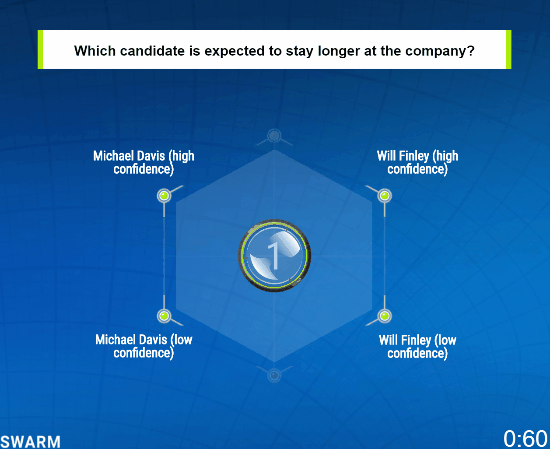
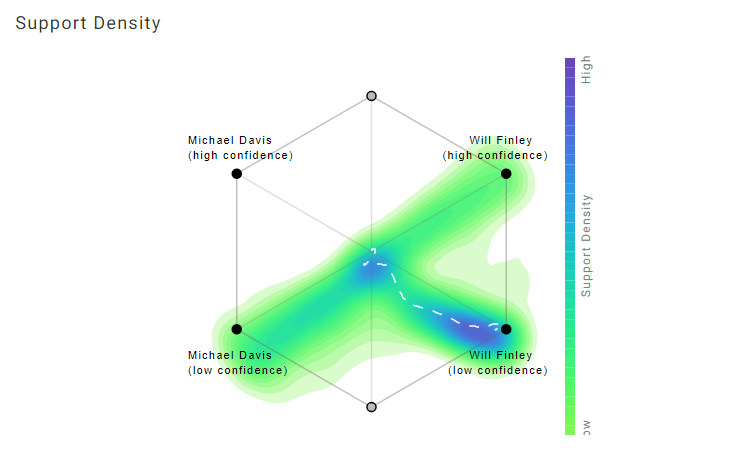
Swarm is a collaborative intelligence platform for generating AI-optimized insights from networked human groups. The power of Swarm is that the underlying algorithms don’t rely on how participants report their sentiments (as reporting can be unreliable and inconsistent), but instead processes how each of the participants behaves when converging in real-time as part of an intelligent system.
This means we can ask what looks like very simple questions and generate very precise answers, so long as the questions elicit complex behaviors in real-time. For example, this this study, the participants were asked to compare two candidates. The question was posed very simply, asking which candidate was most likely to be a long-term employee, and whether it would be by a little or by a lot. But as shown below, this simple question elicits complex behaviors and generates an AI-optimized result.
The first image is a glimpse of the group responding in real-time to the question provided. Each of the magnets is controlled by one of the networked participants, their position and orientation varying over time as the group converges upon an answer. The second image is how the Swarm AI engine views the response of the group, processing their actions, reactions, and interactions.
The team’s output on this singular question is one of part of a series of insights that, when taken as a whole, can be easily interpreted using graphics and charts derived from the Swarm platform’s analytical tools. In this way, the Swarm platform provides the sort of nuanced and comprehensive insight required to solve the complex hiring question, especially between two worthy candidates.
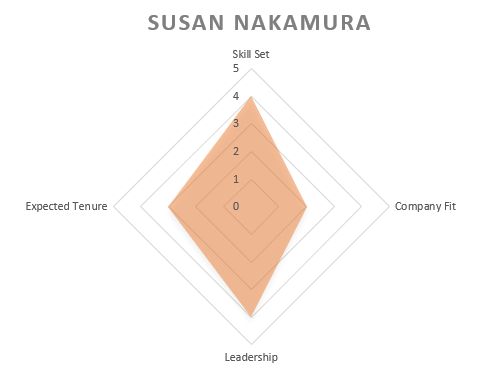
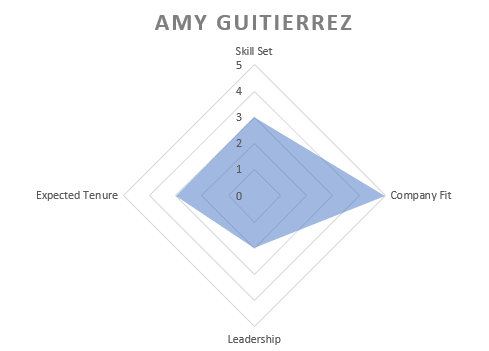
Because hiring decisions are some of the most crucial – choices that an organization must make, any HR department looking for a cutting-edge solution that is both faster and more insightful than legacy methods would do well to consider moving their team onto the new Swarm SaaS platform.
More information about the platform is available at the link below. Or, if you’d like to request an HR-specific demonstration of the platform, please feel free to drop us a line HERE.
Want to learn more about our Swarm AI technology? Check out our TED talk below…




